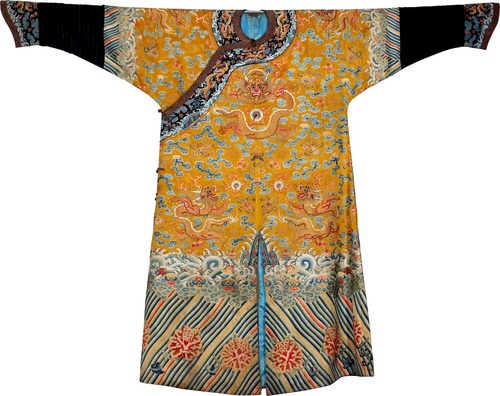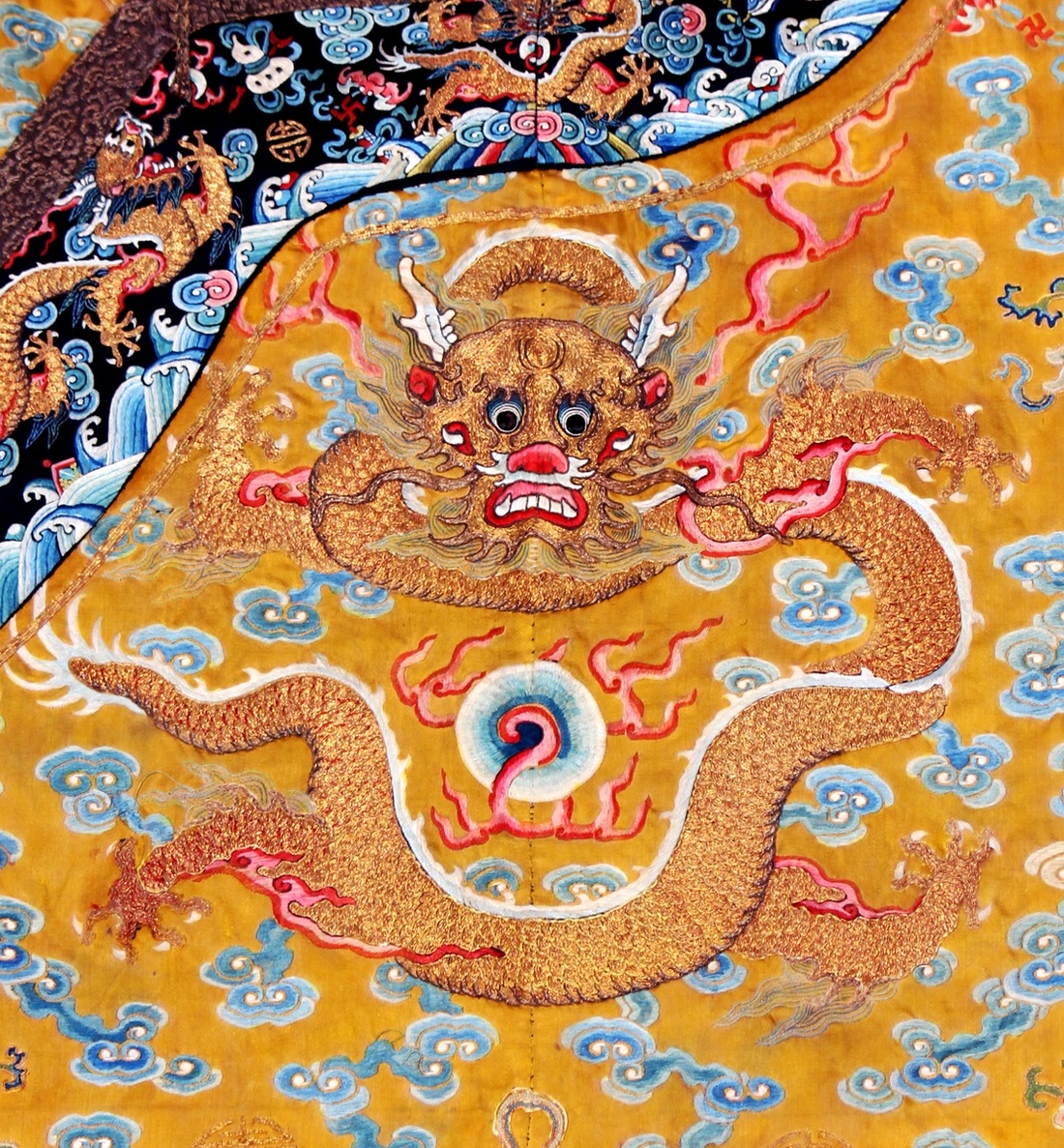Auction: CSS73A - Banknotes, Bonds & Shares and Coins of China and Hong Kong
Lot: 2388
Qing Dynasty, a dragon robe from Daoguang period, This piece was once collected by a family of German representative in China in 1918~1924 and sold in Europe later.
Robes decorated with dragons are the quintessential Qing dynasty garments. They were the dress of imperial government-not its ritual and ceremonial functions, but its civil administration. As a result, they became supreme significant social markers representing access to power. The right to wear such garments was dependent on rank and status.
Throughout history, the Qing Manchus were keenly aware that the image they projected was especially evocative and powerful. From the outset of Manchu ambitions to rule the Chinese empire, dress was an essential tool to communicate legitimacy and heritage. A distinctive form of dress therefore was developed.
The source for the Manchu dragon robes can be traced to the rulers of the previous dynasty. Dragon patterns had decorated Chinese imperial dress since at least the tenth century. Longpao were classified as jifu, literally "auspicious dress," that was worn for occasions celebrating the power and authority of the Qing government. The construction of these robes emphasized multiple fabrics and characteristic features: loop and toggle button fastenings, curved front overlap closing to the right, long tapered sleeves with extensions of contrasting fabric, flaring matixiu, or horse hoof cuffs, deep vents front and back for men and at the sides for women that imitated horse-riding garb.
While the earliest Qing longpao followed the Ming pattern of a single or a pair of dragons extending the full length of the coat,5 from the early-eighteenth century this configuration changed. Manchu dragon robes began displaying a design of nine dragons: four radiating from the neck on the chest, back, and shoulders. These pointed to the direction of the cardinal points on the compass when the wearer was aligned with the strictly north-south orientation of the Forbidden City. Four additional dragons on the skirts-two at the front and two at the back-indicated the intermediate directions. A ninth dragon, unseen, was placed on the inner flap. The dragon robe of the Daoguang period in this auction is exquisite in craftsmanship. The generous space devoted to the dragons, differentiated by size, contrasting those facing the viewer with those shown in three-quarter view, gives the salmon-ground robe a dramatic presence.
The Regulations brought the cosmic purpose of imperial rule into sharp focus. The force of court coat iconography, with its carefully arranged pattern of dragons amid clouds above the universal ocean washing against the earth mountain, quickly transcended the political and ethnic priorities of imperial government to become universal symbols of the empire.
Bright yellow represents the highest level of imperial power in the Qing Dynasty, this dragon robe is definitely an unique gem.
清朝道光時期龍袍一件,由德國駐華代表家族於1918~1924年收藏,後於歐洲售出,輾轉回流。
龍袍乃清代服飾之核心,均象徵皇室朝廷,代表社會上的至高權力,唯有權高位重者,才能穿著如此禮服。
滿清自入關以來,為統御漢族,力求營造出強盛形象,服飾象徵滿族之順天應人、傳承久遠,乃穩固政權的重要工具。且發展一套獨特之服冠制度。
滿清龍袍之形制可回溯自前朝皇服,龍紋成為帝王服飾的裝飾。龍袍又稱吉服袍,主要用於重要吉慶節日,宣揚大清皇權及勢力。龍袍以數種織法及顏色構成:釦絆、右大襟、長窄袖筒前段接綢緞,作馬蹄袖端。
直至十八世紀初,始以九龍紋飾之。前胸、後背及雙肩飾正龍各一,身著龍袍立於南北座向的紫禁城時,四龍即代表國土四方;下擺前後飾行龍各二,意指東北、東南、西北、西南方;裏襟飾龍紋一,不為外露。此次拍賣中這件道光時期龍袍,其工藝精美,緞繡金龍張牙舞爪正對觀者,以正側角度游雲飛翔,整體氣勢萬千。祥龍迎面騰飛,凌厲雄健。
此本詳錄冠服儀制,其中行龍飛騰於江崖海水上之紋飾,儼已變成通世象徵滿清皇權之圖騰,明黃色為清代皇權最高等級,亦為不可多得之珍品。
Estimate
HK$400,000 to HK$1,200,000
Starting price
HK$400000







